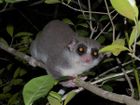رطبة الأنف
| مبتلة الأنف Strepsirrhines | |
|---|---|
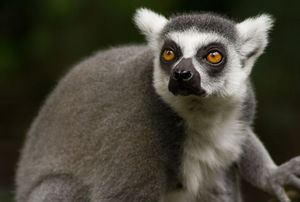
| |
| الليمور دائري الذيل (ليمور كاتا) | |
| التصنيف العلمي | |
| مملكة: | |
| Phylum: | |
| Class: | |
| Order: | |
| Suborder: | مبتلة الأنف إ. جفروا، 1812
|
| تحت رتب | |
|
†Adapiformes | |
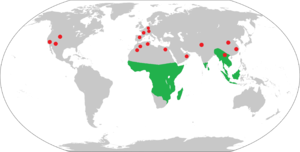
| |
| انتشار حيوانات مبتلة الأنف الحية (الأخضر) ومواقع أحفورات العصر الإيوسيني (الأحمر) | |
مبتلة الأنف Strepsirrhini (/ˌstrɛpsəˈraɪniː/ (![]() استمع); STREP-sə-RY-nee)، هي تحت رتبة من الرئيسيات وتضم رئيسيات شبيهات الليبمور، والتي تشمل ليمور مدغشقر، گالاگو ("صغار الأحراش") والپوتو من أفريقيا، واللوريس من الهند وجنوب شرق آسيا. وهي أيضاً تنتمي إلى تحت رتبة رئيسيات Adapiformes البائدة، وهي مجموعة متنوعة وواسعة النطاق انتشرة في العصر الإيوسيني (56 - 34 مبيون سنة مضت)، في أوروپا، أمريكا الشمالية، وآسيا، لكنها اختفت من معظم نصف الكرة الأرضية الشمالي بسبب برودة المناخ. مات آخر حيواناتها في نهاية العصر الميوسيني (7 مليون سنة مضت)، ويشار إليها أحياناً بشبيهات الليمورات، على الرغم من الاختلافات بين الليمورات وشبيهات الليمورات لا تدعم هذه المقارنة.
استمع); STREP-sə-RY-nee)، هي تحت رتبة من الرئيسيات وتضم رئيسيات شبيهات الليبمور، والتي تشمل ليمور مدغشقر، گالاگو ("صغار الأحراش") والپوتو من أفريقيا، واللوريس من الهند وجنوب شرق آسيا. وهي أيضاً تنتمي إلى تحت رتبة رئيسيات Adapiformes البائدة، وهي مجموعة متنوعة وواسعة النطاق انتشرة في العصر الإيوسيني (56 - 34 مبيون سنة مضت)، في أوروپا، أمريكا الشمالية، وآسيا، لكنها اختفت من معظم نصف الكرة الأرضية الشمالي بسبب برودة المناخ. مات آخر حيواناتها في نهاية العصر الميوسيني (7 مليون سنة مضت)، ويشار إليها أحياناً بشبيهات الليمورات، على الرغم من الاختلافات بين الليمورات وشبيهات الليمورات لا تدعم هذه المقارنة.
التسمية
يشتق اسم "Strepsirrhini " التصنيفي من الكملة الإغريقية "στρεψίς" (سترپسس (strepsis) أو "التحول [نحو الداخل]") وكلمة "ῥινός" (رينوس (rhinos) أو "الأنف") التي تشير إلى ظهور خياشيم متعرجة (على شكل فاصلة) على ريناريوم (rhinarium) أو "الأنف المبلل".[1][2] ولقد قام إتيان جفروا سانت-إلير باستخدام هذا الاسم لأول مرة في عام 1812 كرتبة فرعية بالمقارنة بـ پلاتيرّيني (Platyrrhini) (قرد العالم الحديث) وكاترّينري (Catarrhini) (قرد العالم القديم).[3] وخلال وصفه قام بذكر "لي نارين تيرمنال إي سينيوزي (Les narines terminales et sinueuses)" ("الخياشيم المتعرجة والمُصَفَّية").[4]
التاريخ التطوري
تتكون الرتيبة "ستريبيريني" من 13 فصيلة تنقسم إلى مجموعتين. تتمثل المجموعة الأولى في رتبة ليمورفورمز التي تشتمل على الليمور الموجود في مدغشقر وكذلك لوريز وبوتو وگاگالو. بينما تتمثل المجموعة الثانية في رتبة آدابيفورمز المنقرضة.
ولقد عملت مخططات التصنيف الأولى على تقسيم رتبة الحيوانات الرئيسية إلى الرتب الفرعية لأسلاف القردة (بروسيميان (prosimian)) والبشرانيات (سيميان (simian) - القردة والقردة العليا (ape)). ومع ذلك، اتضح أن تارسير (tarsier) الذي ينتمي إلى أسلاف القردة يكون أكثر قرابة إلى سيميان. ويتم وضع ما تبقى من "بروسيميان" في الوقت الحالي في رتبة "ستريبيريني" بينما يتم توحيد "تارسير" في الوقت الحالي مع "أشباه البشر (anthropoids)" (سيميانز) في "هابلوريني (Haplorrhini)".
| شجرة عائلة الرئيسيات | ||||||||||||||||||||||||||||||||||||||||||||||||
|
| ||||||||||||||||||||||||||||||||||||||||||||||||
| Strepsirrhines and haplorhines diverged shortly after the emergence of the first true primates (euprimates). The relationship between euprimates, treeshrews, colugos, and plesiadapiforms is less certain. Sometimes plesiadapiforms are grouped with the euprimates under the order Primates, colugos are grouped with primates under Primatomorpha, and all four are grouped under Euarchonta.[5] |
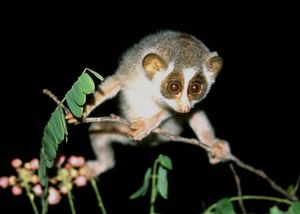
تطور adapiforms

تطور شبيهات الليمورات

التصنيف
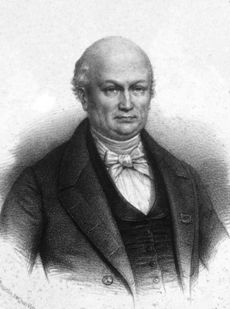
| 2 infraorders[6] | 3 infraorders[7] |
|---|---|
|
|
تسمية تحت الرتب والقبائل
| Strepsirrhini phylogeny[8] | |||||||||||||||||||||||||||||||||
|
|
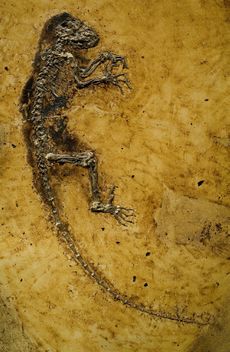
التشريح والفسيولوجيا
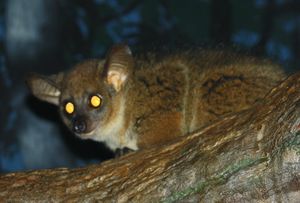

الأنف المبلل والشم
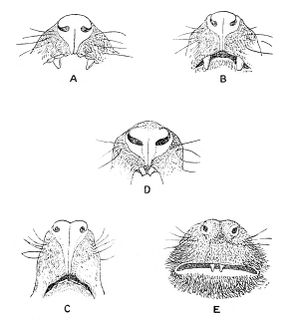
A through D possess a rhinarium and are strepsirrhines, whereas E does not and is a haplorhine.
فسيولوجيا التكاثر
السلوك
التواصل والنظام الاجتماعي
الحركة
النظام الغذائي
الانتشار والموئل
الحفاظ

الهوامش
المصادر
- ^ Ankel-Simons 2007, p. 394.
- ^ Vaughan, Ryan & Czaplewski 2011, p. 169.
- ^ Osman Hill 1953, p. 39.
- ^ Geoffroy Saint-Hilaire 1812, p. 156.
- ^ Rose 2006, pp. 157 & 165–167.
- ^ Cartmill 2010, p. 15.
- ^ Hartwig 2011, pp. 20–21.
- ^ Tabuce et al. 2009, pp. 4091–4092.
خطأ استشهاد: الوسم <ref> ذو الاسم "CNN_13Jul2012" المُعرّف في <references> غير مستخدم في النص السابق.
<ref> ذو الاسم "CITES" المُعرّف في <references> غير مستخدم في النص السابق.المراجع
- Ankel-Simons, F. (2007). Primate Anatomy (3rd ed.). Academic Press. ISBN 978-0-12-372576-9.
{{cite book}}: Invalid|ref=harv(help) - DOI:10.1007/BF02735730 10.1007/BF02735730
This citation will be automatically completed in the next few minutes. You can jump the queue or expand by hand - Campbell, C. J.; Fuentes, A.; MacKinnon, K. C.; Bearder, S. K.; last = Stumpf, R. M, eds. (2011). Primates in Perspective (2nd ed.). Oxford University Press. ISBN 978-0-19-539043-8.
{{cite book}}: Missing pipe in:|editor5=(help)- Gould, L.; Sauther, M.; Cameron, A. (2011). "Chapter 5: Lemuriformes". pp. 55–79.
{{cite book}}: Invalid|ref=harv(help); Missing or empty|title=(help) - Hartwig, W. (2011). "Chapter 3: Primate evolution". pp. 19–31.
{{cite book}}: Invalid|ref=harv(help); Missing or empty|title=(help) - Nekaris, N. A. I.; Bearder, S. K. (2011). "Chapter 4: The lorisiform primates of Asia and mainland Africa: Diversity shrouded in darkness". pp. 34–54.
{{cite book}}: Invalid|ref=harv(help); Missing or empty|title=(help)
- Gould, L.; Sauther, M.; Cameron, A. (2011). "Chapter 5: Lemuriformes". pp. 55–79.
- Cartmill, M. (2010). "Primate Classification and Diversity". In Platt, M.; Ghazanfar, A (eds.). Primate Neuroethology. Oxford University Press. pp. 10–30. ISBN 978-0-19-532659-8.
{{cite book}}: Invalid|ref=harv(help) - Cartmill, M.; Smith, F. H. (2011). The Human Lineage. John Wiley & Sons. ISBN 978-1-118-21145-8.
{{cite book}}: Invalid|ref=harv(help) - Cloninger, C. R.; Kedia, S. (2011). "Chapter 5: The phylogenesis of human personality: Identifying the precursors of cooperation, altruism, and well-being". In Sussman, R. W.; Cloninger, C. R (eds.). Origins of Altruism and Cooperation. Springer. ISBN 978-1-4419-9519-3.
{{cite book}}: Invalid|ref=harv(help) - DOI:10.1016/0047-2484(88)90048-6 10.1016/0047-2484(88)90048-6
This citation will be automatically completed in the next few minutes. You can jump the queue or expand by hand - Dunkel, A. R.; Zijlstra, J. S.; Groves, C. P. (2011/2012). "Giant rabbits, marmosets, and British comedies: etymology of lemur names, part 1" (PDF). Lemur News. 16: 64–70. ISSN 1608-1439.
{{cite journal}}: Check date values in:|year=(help); Invalid|ref=harv(help) - Fitch-Snyder, H.; Livingstone, K. (2008). "Lorises: The Surprise Primate". ZooNooz. San Diego Zoo: 10–14. ISSN 0044-5282.
{{cite journal}}: Invalid|ref=harv(help) - Fichtel, C.; Kappeler, P. M. (2009). "Chapter 19: Human universals and primate symplesiomorphies: Establishing the lemur baseline". In Kappeler, P. M.; Silk, J. B (eds.). Mind the Gap: Tracing the Origins of Human Universals. Springer. pp. 395–426. ISBN 978-3-642-02724-6.
{{cite book}}: Invalid|ref=harv(help) - DOI:10.1371/journal.pone.0005723 10.1371/journal.pone.0005723
This citation will be automatically completed in the next few minutes. You can jump the queue or expand by hand - Geoffroy Saint-Hilaire, É. (1812). "Suite au tableau des quadrumanes. Seconde famille. Lemuriens. Strepsirrhini". Annales du Muséum d'Histoire Naturelle (in French). 19: 156–170.
{{cite journal}}: Invalid|ref=harv(help)CS1 maint: unrecognized language (link) - Gingerich, P. D. (1975). "A new genus of Adapidae (Mammalia, Primates) from the Late Eocene of Southern France, and its significance for the origin of higher primates". Contributions from the Museum of Paleontology, University of Michigan. 24 (15): 163–170.
{{cite journal}}: Invalid|ref=harv(help) - DOI:10.1159/000095391 10.1159/000095391
This citation will be automatically completed in the next few minutes. You can jump the queue or expand by hand - Gould, L.; Sauther, M.L, eds. (2006). Lemurs: Ecology and Adaptation. Springer. ISBN 978-0-387-34585-7.
- Cuozzo, F.P.; Yamashita, N. (2006). "Chapter 4: Impact of Ecology on the Teeth of Extant Lemurs: A Review of Dental Adaptations, Function, and Life History". pp. 67–96. ISBN 978-0-387-34585-7 http://www.google.com/books?id=nsBtrhsMU5EC&pg=PA67.
{{cite book}}: Invalid|ref=harv(help); Missing or empty|title=(help) - Tattersall, I. (2006). "Chapter 1: Origin of the Malagasy Strepsirhine Primates". pp. 3–18 http://www.google.com/books?id=nsBtrhsMU5EC&pg=PA3.
{{cite book}}: Invalid|ref=harv(help); Missing or empty|title=(help)
- Cuozzo, F.P.; Yamashita, N. (2006). "Chapter 4: Impact of Ecology on the Teeth of Extant Lemurs: A Review of Dental Adaptations, Function, and Life History". pp. 67–96. ISBN 978-0-387-34585-7 http://www.google.com/books?id=nsBtrhsMU5EC&pg=PA67.
- DOI:10.1007/BF02557740 10.1007/BF02557740
This citation will be automatically completed in the next few minutes. You can jump the queue or expand by hand - Groves, C. P. (2005). "Strepsirrhini". In Wilson, D. E.; Reeder, D. M (eds.). Mammal Species of the World (3rd ed.). Baltimore: Johns Hopkins University Press. p. 111. OCLC 62265494. ISBN 0-801-88221-4.
{{cite book}}: Invalid|ref=harv(help) - Groves, C. P. (2008). Extended Family: Long Lost Cousins: A Personal Look at the History of Primatology. Conservation International. ISBN 978-1-934151-25-9.
{{cite book}}: Invalid|ref=harv(help) - Hartwig, W. C, ed. (2002). The primate fossil record. Cambridge University Press. ISBN 978-0-521-66315-1.
- Beard, K. C. (2002). "Chapter 9: Basal anthropoids". pp. 133–149 http://books.google.com/books?id=Ezm1OA_s6isC&pg=PA133.
{{cite book}}: Invalid|ref=harv(help); Missing or empty|title=(help) - Covert, H. H. (2002). "Chapter 3: The earliest fossil primates and the evolution of prosimians: Introduction". pp. 13–20 http://books.google.com/books?id=Ezm1OA_s6isC&pg=PA13&lpg=PA13.
{{cite book}}: Invalid|ref=harv(help); Missing or empty|title=(help) - Gebo, D. L. (2002). "Chapter 4: Adapiformes: Phylogeny and adaptation". pp. 21–44 http://books.google.com/books?id=Ezm1OA_s6isC&pg=PA21.
{{cite book}}: Invalid|ref=harv(help); Missing or empty|title=(help) - Godfrey, L. R.; Jungers, W. L. (2002). "Chapter 7: Quaternary fossil lemurs". pp. 97–121 http://books.google.com/books?id=Ezm1OA_s6isC&pg=PA97.
{{cite book}}: Invalid|ref=harv(help); Missing or empty|title=(help)
- Beard, K. C. (2002). "Chapter 9: Basal anthropoids". pp. 133–149 http://books.google.com/books?id=Ezm1OA_s6isC&pg=PA133.
- Jenkins, P. D.; Napier, P. H. (1987). Catalogue of Primates in the British Museum (Natural History) and elsewhere in the British Isles, Part 4, Suborder Strepsirrhini, including the subfossil Madagascan lemurs and family Tarsiidae. British Museum (Natural History). ISBN 978-0-565-01008-9.
{{cite book}}: Invalid|ref=harv(help) - DOI:10.1002/ajpa.20352 10.1002/ajpa.20352
This citation will be automatically completed in the next few minutes. You can jump the queue or expand by hand - Mittermeier, R. A.; Rylands, A. B.; Konstant, W. R. (1999). "Primates of the world: An introduction". In Nowak, R. M (ed.). Walker's Mammals of the World (6th ed.). Johns Hopkins University Press. pp. 1–52. ISBN 978-0-8018-6251-9.
{{cite book}}: Invalid|ref=harv(help) - DOI:10.1002/ajp.20842 10.1002/ajp.20842
This citation will be automatically completed in the next few minutes. You can jump the queue or expand by hand - Osman Hill, W.C. (1953). Primates Comparative Anatomy and Taxonomy I—Strepsirhini. Edinburgh Univ Pubs Science & Maths, No 3. Edinburgh University Press. OCLC 500576914.
{{cite book}}: Invalid|ref=harv(help) - Overdorff, D. J.; Tecot, S. R. (2006). "Chapter 11: Social pair-bonding and resource defense in wild red-bellied lemurs (Eulemur rubriventer)". In Gould, L.; Sauther, M. L (eds.). Lemurs: Ecology and Adaptation. Springer. pp. 235–254. doi:10.1007/978-0-387-34586-4_11. ISBN 978-0-387-34585-7.
{{cite book}}: Invalid|ref=harv(help) - Plavcan, J. M. (2004). "Chapter 13: Sexual selection, measures of sexual selection, and sexual dimorphism in primates". In Kappeler, P. M.; van Schaik, C. P (eds.). Sexual Selection in Primates: New and Comparative Perspectives. Cambridge University Press. pp. 230–252. ISBN 978-0-521-53738-4.
{{cite book}}: Invalid|ref=harv(help) - DOI:10.1111/j.1096-3642.1918.tb02076.x 10.1111/j.1096-3642.1918.tb02076.x
This citation will be automatically completed in the next few minutes. You can jump the queue or expand by hand - DOI:10.1159/000052716 10.1159/000052716
This citation will be automatically completed in the next few minutes. You can jump the queue or expand by hand - Rose, K. D. (2006). The Beginning of the Age of Mammals. Johns Hopkins University Press. ISBN 978-0-8018-8472-6.
{{cite book}}: Invalid|ref=harv(help) - DOI:10.1073/pnas.1119506109 10.1073/pnas.1119506109
This citation will be automatically completed in the next few minutes. You can jump the queue or expand by hand - Sussman, R. W. (2003). Primate Ecology and Social Structure. Pearson Custom Publishing. ISBN 978-0-536-74363-3.
{{cite book}}: Invalid|ref=harv(help) - DOI:10.1098/rspb.2009.1339
This citation will be automatically completed in the next few minutes. You can jump the queue or expand by hand - Vaughan, T.; Ryan, J.; Czaplewski, N. (2011). "Chapter 12: Primates". Mammalogy (5th ed.). Jones & Bartlett Learning. ISBN 978-0-7637-6299-5.
{{cite book}}: Invalid|ref=harv(help) - Whitten, P. L.; Brockman, D. K. (2001). "Chapter 14: Strepsirrhine reproductive ecology". In Ellison, P. T (ed.). Reproductive Ecology and Human Evolution. Transaction Publishers. pp. 321–350. ISBN 978-0-202-30658-2.
{{cite book}}: Invalid|ref=harv(help) - DOI:10.1016/j.jhevol.2010.01.003 10.1016/j.jhevol.2010.01.003
This citation will be automatically completed in the next few minutes. You can jump the queue or expand by hand - Wright, P. C, ed. (2003). Tarsiers: Past, Present, and Future. Rutgers University Press. ISBN 978-0-8135-3236-3.
- Schwartz, J. H. (2003). "Chapter 3: How close are the similarities between Tarsius and other primates?". pp. 50–96 http://books.google.com/books?id=9g_TwVzDOI0C&pg=PA50.
{{cite book}}: Invalid|ref=harv(help); Missing or empty|title=(help) - Simons, E. L. (2003). "Chapter 1: The fossil record of tarsier evolution". pp. 9–34 http://books.google.com/books?id=9g_TwVzDOI0C&pg=PA9.
{{cite book}}: Invalid|ref=harv(help); Missing or empty|title=(help) - Yoder, A. D. (2003). "Chapter 7: The phylogenetic position of the genus Tarsius: Who's side are you on?". pp. 161–175 http://books.google.com/books?id=9g_TwVzDOI0C&pg=PA161.
{{cite book}}: Invalid|ref=harv(help); Missing or empty|title=(help)
- Schwartz, J. H. (2003). "Chapter 3: How close are the similarities between Tarsius and other primates?". pp. 50–96 http://books.google.com/books?id=9g_TwVzDOI0C&pg=PA50.

